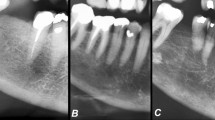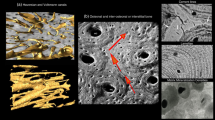Abstract
Objectives
The objectives of the investigation were to describe changes in mandibular bone structure with aging and to compare the usefulness of cortical and trabecular bone for fracture prediction.
Materials and methods
From 1968 to 1993, 1,003 women were examined. With the help of panoramic radiographs, cortex thickness was measured and cortex was categorized as: normal, moderately, or severely eroded. The trabeculation was assessed as sparse, mixed, or dense.
Results
Visually, the mandibular compact and trabecular bone transformed gradually during the 24 years. The compact bone became more porous, the intertrabecular spaces increased, and the radiographic image of the trabeculae seemed less mineralized. Cortex thickness increased up to the age of 50 and decreased significantly thereafter. At all examinations, the sparse trabeculation group had more fractures (71–78 %) than the non-sparse group (27–31 %), whereas the severely eroded compact group showed more fractures than the less eroded groups only in 1992/1993, 24 years later. Sparse trabecular pattern was associated with future fractures both in perimenopausal and older women (relative risk (RR), 1.47–4.37) and cortical erosion in older women (RR, 1.35–1.55). RR for future fracture associated with a severely eroded cortex increased to 4.98 for cohort 1930 in 1992/1993. RR for future fracture associated with sparse trabeculation increased to 11.43 for cohort 1922 in 1992/1993.
Conclusion
Dental radiographs contain enough information to identify women most at risk of future fracture.
Clinical relevance
When observing sparse mandibular trabeculation, dentists can identify 40–69 % of women at risk for future fractures, depending on participant age at examination.

Similar content being viewed by others
References
Genant HK, Jiang Y (2006) Advanced imaging assessment of bone quality. Ann N Y Acad Sci 1068:410–428
Pasco JA, Seeman E, Henry MJ, Merriman EN, Nicholson GC, Kotowicz MA (2006) The population burden of fractures originates in women with osteopenia, not osteoporosis. Osteoporos Int 17:1404–1409
White SC, Atchison KA, Gornbein JA, Nattiv A, Paganini-Hill A, Service SK (2006) Risk factors for fractures in older men and women: the Leisure World Cohort Study. Gend Med 3:110–123
Jonasson G, Alstad T, Vahedi F, Bosaeus I, Lissner L, Hakeberg M (2009) Trabecular pattern in the mandible as bone fracture predictor. Oral Surg Oral Med Oral Pathol Oral Radiol Endod 108:e42–e51
Jonasson G, Sundh V, Ahlqwist M, Hakeberg M, Björkelund C, Lissner L (2011) A prospective study of mandibular trabecular bone to predict fracture risk: a low-cost screening tool in the dental clinic. Bone 49:873–879
Bengtsson C, Ahlqwist M, Andersson K, Björkelund C, Lissner L, Söderström M (1997) The Prospective Population Study of Women in Gothenburg, Sweden, 1968–69 to 1992–93. A 24-year follow-up study with special reference to participation, representativeness, and mortality. Scand J Prim Health Care 15:214–219
Klemetti E, Kolmakov S, Kröger H (1994) Pantomography in assessment of the osteoporosis risk group. Scand J Dent Res 102:68–72
Taguchi A, Asano A, Ohtsuka M, Nakamoto T, Suei Y, Tsuda M et al (2008) Observer performance in diagnosing osteoporosis by dental panoramic radiographs: results from the osteoporosis screening project in dentistry (OSPD). Bone 43:209–213
Devlin H, Karayianni K, Mitsea A, Jacobs R, Lindh C, van der Stelt P, Marjanovic E, Adams J, Pavitt S, Horner K (2007) Diagnosing osteoporosis by using dental panoramic radiographs: the OSTEODENT project. Oral Surg Oral Med Oral Pathol Oral Radiol Endod 104:821–828
Ulm C, Solar P, Blahout R, Matejka M, Gruber H (1992) Reduction of the compact and cancellous bone substances of the edentulous mandible caused by resorption. Oral Surg Oral Med Oral Pathol 74:131–136
Lindh C, Petersson A, Rohlin M (1996) Assessment of the trabecular pattern before endosseous implant treatment: diagnostic outcome of periapical radiography in the mandible. Oral Surg Oral Med Oral Pathol Oral Radiol Endod 82:335–343
Jonasson G, Bankvall G, Kiliaridis S (2001) Estimation of skeletal bone mineral density by means of the trabecular pattern of the alveolar bone, its interdental thickness, and the bone mass of the mandible. Oral Surg Oral Med Oral Pathol Oral Radiol Endod 92:346–352
Riggs BL, Khosla S, Atkinson EJ, Dunstan CR, Melton LJ 3rd (2003) Evidence that type I osteoporosis results from enhanced responsiveness of bone to estrogen deficiency. Osteoporos Int 14:728–733
Bollen AM, Taguchi A, Hujoel PP, Hollender LG (2000) Case–control study on self-reported osteoporotic fractures and mandibular cortical bone. Oral Surg Oral Med Oral Pathol Oral Radiol Endod 90:518–524
Atkinson PJ, Woodhead C (1968) Changes in human mandibular structure with age. Arch Oral Biol 13:1453–1463
Weinstein RS, Hutson MS (1987) Decreased trabecular width and increased trabecular spacing contribute to bone loss with aging. Bone 8:137–142
White SC, Rudolph DJ (1999). Alterations of the trabecular pattern of the jaws in patients with osteoporosis. Oral Surg Oral Med Oral Pathol Oral Radiol Endod. 88:628–35. |
White SC, Atchison KA, Gornbein JA, Nattiv A, Paganini-Hill A, Service SK, Yoon DC (2005) Change in mandibular trabecular pattern and hip fracture rate in elderly women. Dentomaxillofac Radiol 34:168–174
Sornay-Rendu E, Boutroy S, Munoz F, Delmas PD (2007) Alterations of cortical and trabecular architecture are associated with fractures in postmenopausal women, partially independent of decreased BMD measured by DXA: the OFELY study. J Bone Miner Res 22:425–433
Korstjens CM, Mosekilde L, Spruijt RJ, Geraets WG, van der Stelt PF (1996) Relations between radiographic trabecular pattern and biomechanical characteristics of human vertebrae. Acta Radiol 37:618–624
Jett S, Shrout MK, Mailhot JH, Potter BJ, Borke JL (2004) An evaluation of the origin of trabecular bone patterns using visual and digital image analysis. Oral Surg Oral Med Oral Pathol Oral Radiol Endod 98:598–604
Okabe S, Morimoto Y, Ansai T, Yoshioka I, Tanaka T, Taguchi A et al (2008) Assessment of the relationship between the mandibular cortex on panoramic radiographs and the risk of bone fracture and vascular disease in 80-years-olds. Oral Surg Oral Med Oral Pathol Oral Radiol Endod 106:433–442
Jonasson G, Jonasson L, Kiliaridis S (2006) Changes in the radiographic characteristics of the mandibular alveolar process in dentate women with varying bone mineral density: a five-year prospective study. Bone 38:714–721
Jonasson G, Jonasson L, Kiliaridis S (2007) Skeletal bone mineral density in relation to thickness, bone mass, and structure of the mandibular alveolar process in dentate men and women. Eur J Oral Sci 115:117–123
Pham D, Jonasson G, Kiliaridis S (2010) Assessment of trabecular pattern on periapical and panoramic radiographs: a pilot study. Acta Odontol Scand 68:91–97
Southard TE, Southard K, Lee A (2001) Alveolar process fractal dimension and postcranial bone density. Oral Surg Oral Med Oral Pathol Oral Radiol Endod 91:486–491
Devlin H, Allen PD, Graham J, Jacobs R, Karayianni C, Lindh C et al (2007) Automated osteoporosis risk assessment by dentists: a new pathway to diagnosis. Bone 40:835–842
Horner K, Allen P, Graham J, Jacobs R, Boonen S, Pavitt S et al (2010) The relationship between the OSTEODENT index and hip fracture risk assessment using FRAX. Oral Surg Oral Med Oral Pathol Oral Radiol Endod 110:243–249
Kingsmill VJ, Boyde A (1998) Variation in the apparent density of human mandibular bone with age and dental status. J Anat 192:233–244
Ulm CW, Kneissel M, Hahn M, Solar P, Matejka M, Donath K (1997) Characteristics of the cancellous bone of edentulous mandibles. Clin Oral Implants Res 8:125–130
Filleul O, Crompot E, Saussez S (2010) Bisphosphonate-induced osteonecrosis of the jaw: a review of 2.400 patient cases. J Cancer Res Clin Oncol 136:1117–1124
Acknowledgements
This study was funded by research grants from the Health and Medical Care Committee of the Regional Executive Board, Region Västra Götaland, the Research and Development Councils of Southern Älvsborg and Göteborg and Southern Bohuslän Counties, the Swedish Council for Working Life and Social Research (FAS Center EpiLife), and the Swedish Research Council. No commercial funding was received and no conflicts of interest exist.
Author information
Authors and Affiliations
Corresponding author
Rights and permissions
About this article
Cite this article
Jonasson, G., Sundh, V., Hakeberg, M. et al. Mandibular bone changes in 24 years and skeletal fracture prediction. Clin Oral Invest 17, 565–572 (2013). https://doi.org/10.1007/s00784-012-0745-x
Received:
Accepted:
Published:
Issue Date:
DOI: https://doi.org/10.1007/s00784-012-0745-x




